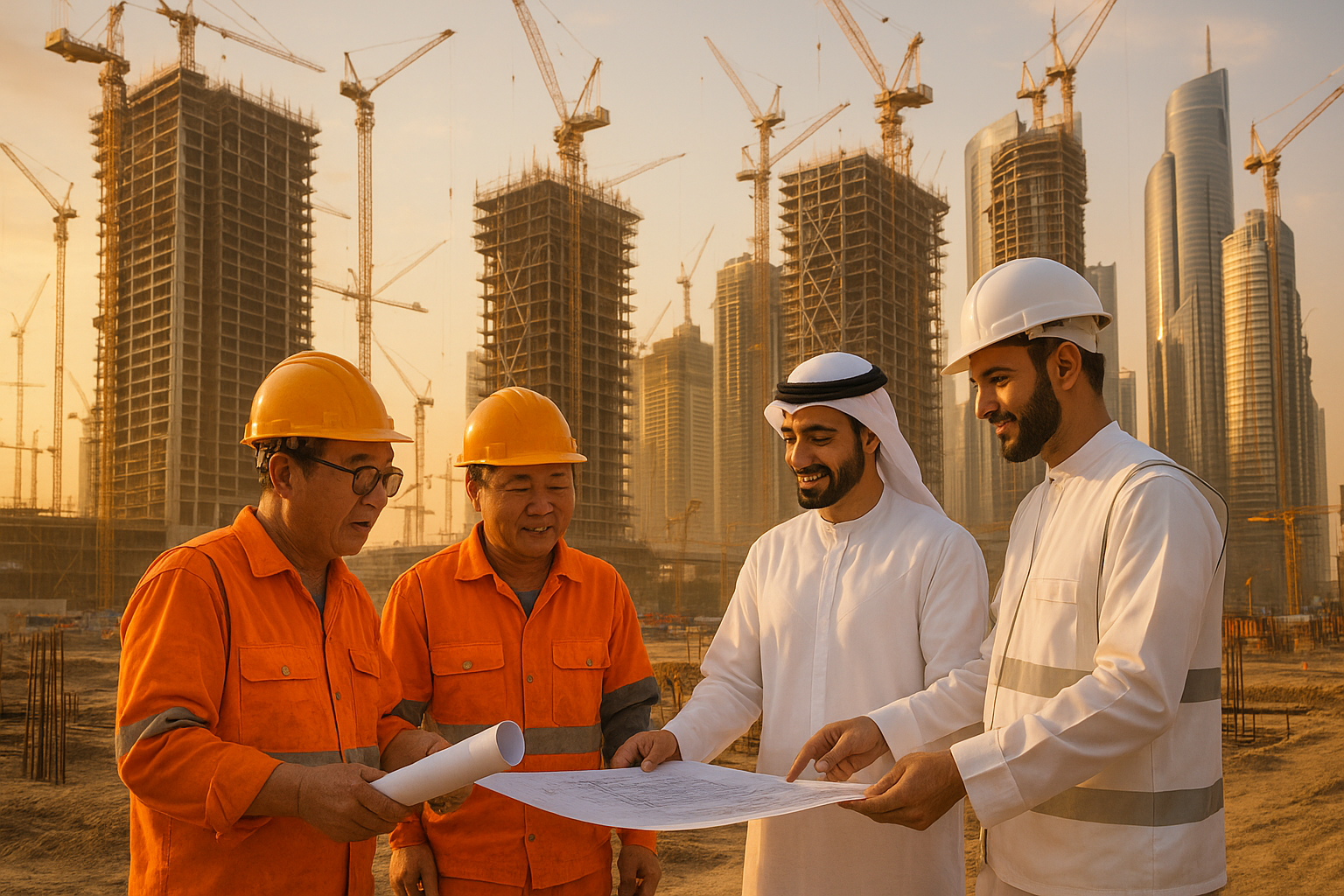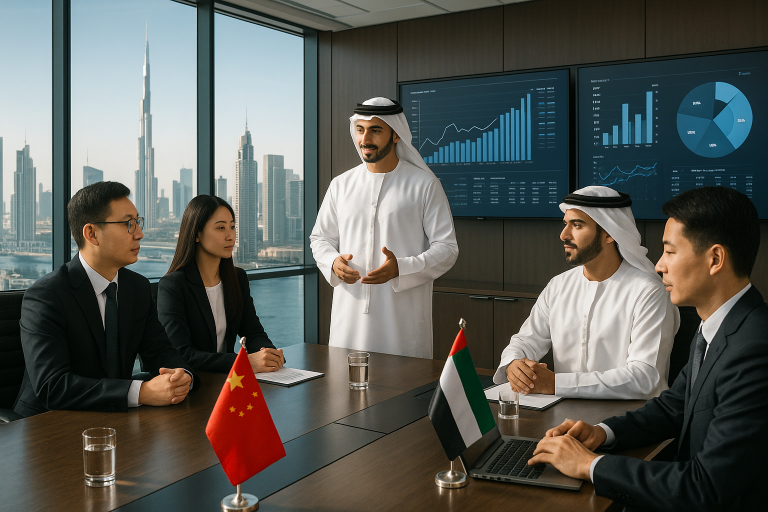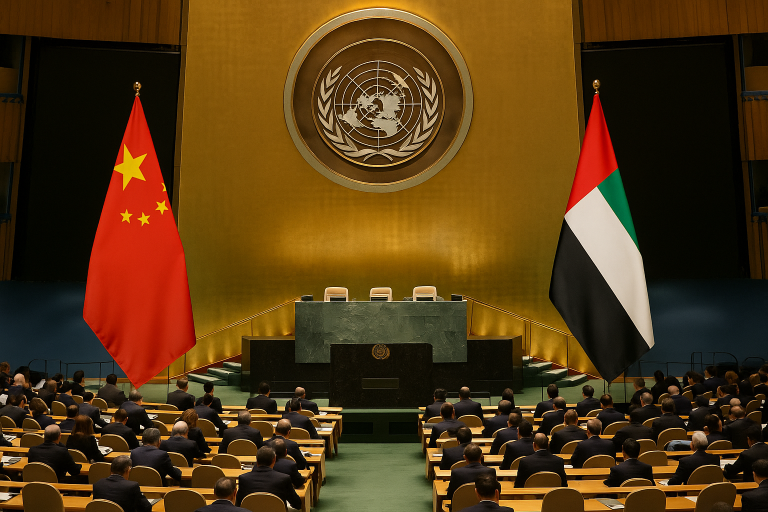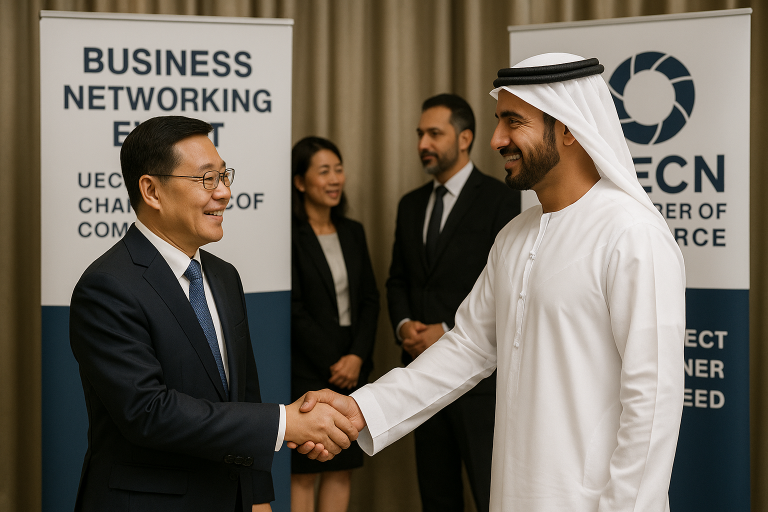Real Estate and Construction: Building Tomorrow’s Cities Together
Introduction
The iconic, globally recognized skylines of Dubai and Abu Dhabi are powerful symbols of the United Arab Emirates’ ambition, vision, and rapid development. These futuristic cityscapes, with their record-breaking towers and daring architectural feats, are a testament to the nation’s ability to turn bold dreams into concrete reality. What is often unseen, however, is the crucial role that international partnerships have played in creating this modern marvel. Among the most significant of these is the deep and enduring collaboration with the People’s Republic of China in the fields of real estate and construction. This powerful force has physically shaped the future of the UAE, combining the immense scale, technical prowess, and speed of Chinese construction giants with the UAE’s visionary urban development plans. The result is a partnership that is not just written in contracts and agreements, but is etched in steel and glass across the nation’s skylines. This article delves into the key facets of this concrete collaboration, exploring the foundational role of Chinese companies in building the UAE’s landmark projects, the significant and growing flow of Chinese investment into the nation’s real estate market, the joint adoption of cutting-edge construction technology, and the shared vision for co-developing the smart, sustainable cities of the future.
The Architects of Ambition: Chinese Construction in the UAE
Over the past two decades, as the UAE embarked on one of the most ambitious building booms in human history, Chinese state-owned construction and engineering firms have been indispensable partners. Companies like the China State Construction Engineering Corporation (CSCEC), a global behemoth in the industry, have been deeply involved in bringing some of the UAE’s most complex and iconic projects to life. Their role has extended far beyond that of simple contractors; they have been strategic partners, bringing unparalleled technical capability, vast manpower resources, and a legendary ability to deliver massive projects on accelerated timelines.
Case Study 1: Landmark Infrastructure
The backbone of any modern economy is its infrastructure, and Chinese construction firms have been instrumental in building the UAE’s world-class transportation network. A prime example is their significant involvement in the construction of major airport terminals. These are not just buildings but are immensely complex civil engineering projects, requiring the integration of countless systems. The successful and timely delivery of such projects has been critical to cementing the UAE’s status as a global hub for travel and logistics. Similarly, Chinese firms have been key players in the expansion of the UAE’s vast road networks, building intricate interchanges and expressways that ensure the smooth flow of people and commerce across the country.
Case Study 2: Iconic Towers and Developments
The most visible evidence of the partnership is in the skylines themselves. Chinese construction companies have been the driving force behind numerous landmark towers, sprawling residential complexes, and luxurious hospitality projects. They have demonstrated the technical expertise to execute the most challenging architectural designs, from super-tall skyscrapers with complex geometries to vast, master-planned communities. Their ability to mobilize resources and manage complex supply chains has allowed them to deliver these mega-projects with a speed and efficiency that has become a hallmark of the UAE’s development model. Every time a resident moves into a new apartment, a tourist checks into a luxury hotel, or an employee works in a gleaming office tower, there is a high probability that the skill and labor of this China-UAE construction partnership played a role in making it possible.
The Flow of Capital: Chinese Investment in UAE Real Estate
The partnership is not just about building; it is also about investing. The UAE, and particularly Dubai, has firmly established itself as a top global destination for Chinese real estate investors, attracting a significant and growing flow of capital from both large corporations and private individual buyers. This influx of investment has been a major contributor to the growth, resilience, and dynamism of the UAE’s property market.
The drivers behind this investment are multifaceted. For Chinese investors, the UAE represents a safe-haven asset in a sometimes-volatile global economic climate. The country’s political stability, its currency’s peg to the US dollar, and its transparent legal framework provide a sense of security that is highly valued. The financial returns are also highly attractive. The UAE’s real estate market, particularly in Dubai, offers some of the most competitive rental yields among major global cities, providing investors with a steady stream of income. Furthermore, the pro-business environment, which includes the absence of property taxes, adds another layer of financial appeal.
Government initiatives have also played a crucial role in attracting this investment. The UAE Golden Visa program, for instance, has been a game-changer. By offering long-term, 10-year residency to individuals who make a significant investment in local property, the government has created a powerful incentive for investors to put down roots in the country. This has been particularly appealing to Chinese investors seeking a secure, high-quality lifestyle for their families, along with the benefits of a global business hub. The result has been a surge of Chinese capital into the market, fueling the development of new residential and commercial districts and broadening the international appeal of the UAE’s real estate offering.
Innovation in Construction: Building Smarter and Greener
The China-UAE construction partnership is rapidly evolving beyond the traditional model of bricks and mortar. Both sides are committed to innovation and are actively collaborating to build the next generation of buildings in a way that is smarter, faster, and more sustainable. This involves a conscious shift away from conventional construction methods and an enthusiastic embrace of new technologies and green building principles.
One of the key areas of innovation is the adoption of pre-fabricated and modular construction. This modern method involves manufacturing large sections of a building off-site in a controlled factory environment. These modules are then transported to the construction site and assembled. This technique, in which Chinese firms have extensive experience, dramatically increases the speed of construction, improves quality control, and enhances worker safety. The partnership is also at the forefront of using 3D printing in construction. The UAE has an ambitious strategy to have 25% of its new buildings be 3D printed by 2030, and collaboration with Chinese expertise is helping to make this vision a reality, from printing complex building components to entire structures.
Sustainability is another core pillar of the innovation drive. The UAE has implemented stringent green building standards, such as the Estidama rating system in Abu Dhabi and the Al Sa’fat regulations in Dubai. Chinese construction firms operating in the country are not just adhering to these standards but are actively contributing to their implementation. This includes the use of sustainable and recycled building materials, the incorporation of energy-efficient designs that reduce cooling and lighting costs, and the implementation of water-saving technologies. This joint commitment to green building is helping to reduce the environmental footprint of the UAE’s urban development and is creating a legacy of sustainable architecture.
The Future: Co-Developing the Cities of Tomorrow
The relationship between Chinese firms and their Emirati partners is undergoing a significant evolution. Increasingly, Chinese companies are transitioning from being just contractors to becoming strategic co-developers and long-term investors in new, large-scale urban projects. This deeper form of partnership involves being part of the entire project lifecycle, from initial planning and design to financing, construction, and long-term facility management.
The ultimate expression of this future collaboration lies in the joint development of entire smart city districts from the ground up. This is a holistic vision that goes far beyond just constructing buildings. It involves meticulously planning and integrating the digital infrastructure that will make a city truly “smart.” This includes embedding IoT (Internet of Things) connectivity into the urban fabric, creating smart utility grids that optimize energy and water consumption, designing autonomous transportation systems, and building centralized data platforms to manage city services efficiently. By collaborating from the very first blueprint, China and the UAE can co-create urban environments that are not only architecturally stunning but are also intelligent, responsive, and highly sustainable.
In this complex, multi-party endeavor, the UAE China Chamber of Commerce (UECN) plays an indispensable role. It serves as the central platform connecting visionary developers, major investors, world-class construction companies, and cutting-edge technology providers. The Chamber facilitates the intricate partnerships required to bring these ambitious, city-scale projects to fruition, ensuring that the collaboration is smooth, efficient, and mutually beneficial.
Conclusion: A Concrete Partnership
The collaboration between China and the UAE in real estate and construction has a unique and undeniable legacy: it is a partnership that is written in the very steel and glass of the nation’s skylines. It is a concrete and tangible representation of the depth and strength of their bilateral ties. The immense construction prowess of Chinese firms has helped to realize the UAE’s ambitious urban vision, while the flow of Chinese investment has added fuel to the engine of its real estate market. Now, as the partnership evolves and deepens, it is setting its sights on a new frontier: the joint pursuit of technological and sustainable innovation. Together, China and the UAE are doing more than just erecting buildings; they are creating world-class, resilient, and intelligent urban environments that will serve as a global benchmark for the cities of the 21st century and beyond.







